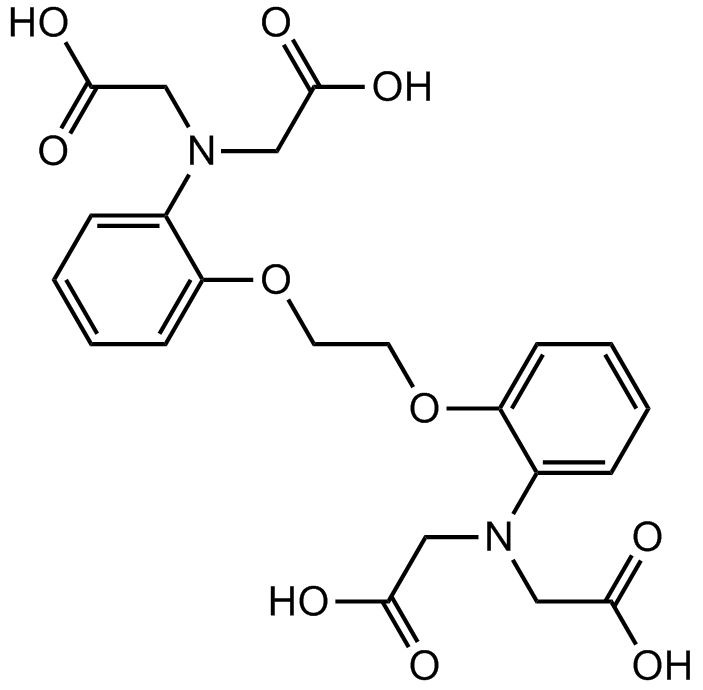BAPTA |
| Catalog No.GC17574 |
calcium chelator
Products are for research use only. Not for human use. We do not sell to patients.

Cas No.: 85233-19-8
Sample solution is provided at 25 µL, 10mM.
BAPTA is a calcium chelator. BAPTA suppresses intracellular reactive oxygen species (ROS) levels.
Regarding ROS generation, a Ca2+ specific chelator, BAPTA, suppresses ROS generation of Sodium lauryl sulfate (SLS)-exposed HaCaT keratinocytes[1]. Depolarization does not increase the resting open probability of the mechanoelectrical transducer (MET) current of Tmc1Bth/Bth OHCs, whereas raising the intracellular concentration of the Ca2+ chelator BAPTA causes smaller increases in resting open probability in Bthmutant outer hair cells (OHCs) than in wild-type control cells. In the presence of 0.1 mM BAPTA, nonsaturating bundle displacements causes the MET current to adapt in both genotypes, exactly as seen when 1 mM EGTA is used in the intracellular solution. In the presence of 10 mM intracellular BAPTA, the time-dependent MET current decline is abolished and the resting Popen increased to near 50% of the maximal MET current in OHCs from both Tmc1+/+ and Tmc1Bth/Bth mice. The relation between the MET current and bundle displacement shows that increasing the intracellular BAPTA concentration from 0.1 to 10 mM significantly increased (p<0.0001) the resting Popen of the MET current in both Tmc1+/+ (0.1 mM, 8±1.6%, n=4; 10 mM, 39.6±2.7%, n=5) and Tmc1Bth/Bth (0.1 mM, 10.4±2.2%, n=3; 10 mM, 46.5±9.9%, n=6). No significant differences are seen between the two genotypes for both BAPTA concentrations. However, 3 and 5 mM BAPTA are less effective in shifting the MET current-bundle displacement curves in Tmc1Bth/Bth than in Tmc1+/+ OHCs. In Tmc1+/+, increasing the BAPTA concentration from 0.1 mM to either 3 or 5 mM produces a highly significant increase in Popen (post hoc test from one-way ANOVA, p<0.01 and p<0.001, respectively); in Tmc1Bth/Bth, the same comparison produced no or a much reduced increase in Popen (n.s. and p<0.05, respectively)[2].
References:
[1]. Mizutani T, et al. Sodium Lauryl Sulfate Stimulates the Generation of Reactive Oxygen Species through Interactions with Cell Membranes. J Oleo Sci. 2016 Dec 1;65(12):993-1001.
[2]. Corns LF, et al. Tmc1 Point Mutation Affects Ca2+ Sensitivity and Block by Dihydrostreptomycin of the Mechanoelectrical Transducer Current of Mouse Outer Hair Cells. J Neurosci. 2016 Jan 13;36(2):336-49.
Average Rating: 5 (Based on Reviews and 17 reference(s) in Google Scholar.)
GLPBIO products are for RESEARCH USE ONLY. Please make sure your review or question is research based.
Required fields are marked with *




















